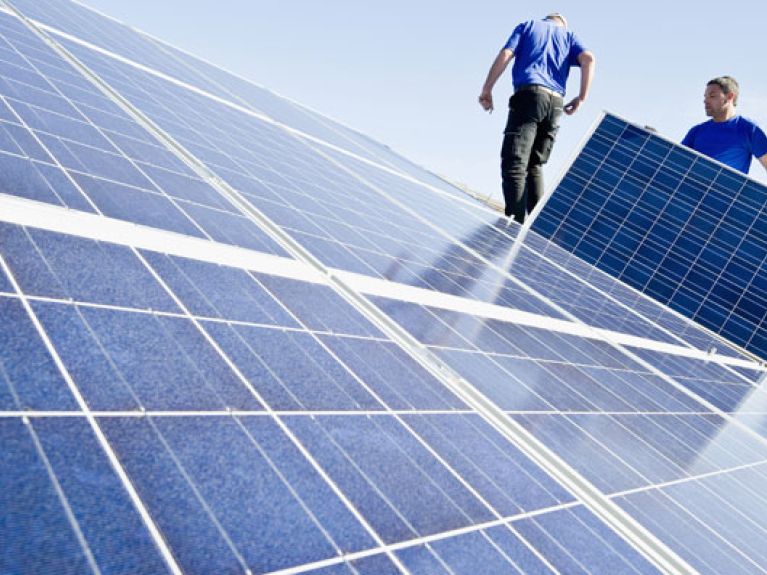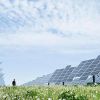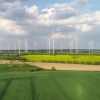The transition to renewable energy
In Germany the transition to a sustainable energy supply system has been a goal since the 1970s.

1976
Wind energy experiment
Wind energy is not only considered a means of reducing dependence on fossil fuels after the oil crises of the 1970s. A technological advance is planned in 1976 when the Research Ministry decides to build a 100-metre, 340-tonne wind turbine (Growian) in northern Germany. After numerous delays the test installation is only completed in 1983 – and proves a failure. Growian is demolished in 1988.
1984
Enercon is born
In 1984 a Frisian inventor called Aloys Wobben builds a wind generator in his shed. His Enercon business starts to grow in size until eventually in 1992 Wobben develops a gearless wind generator that enables new wind turbines to run better and more reliably. Today the company is one of the most important on the world market.
1987
First German wind farm
On 24 August 1987 the first German wind farm begins operating in Kaiser-Wilhelm-Koog on the west coast of Schleswig-Holstein. From that day onwards, 32 different wind turbines with capacities of between 10 and 25 kilowatts begin converting the North Sea wind into electric current.
1990
Rooftop energy
A project called 1,000 Roofs is launched. Eventually a total of 2,550 roofs are fitted with photovoltaic cells (total capacity: 6 megawatts). Solar electricity takes off.
1991
Law for renewables
The Electricity Feed-In Act comes into force on 1 January 1991, shortly after being passed by the Bundestag. For the first time this new law obliges large electricity companies to accept and remunerate electrical energy generated using renewable sources (hydro power, wind power, solar energy, landfill gas, sewage gas and biomass) with fixed tariffs. This makes it much easier to feed “green electricity” into the grid. The new law is the precursor of the Renewable Energy Sources Act (EEG) that comes into force in the year 2000.
1992
Rio Earth Summit
The 1992 Earth Summit in Brazil makes the threat of climate change a global topic. By the end of the 1990s there has been a tenfold increase in the number of wind turbines in Germany. Additional solar plants and new funding models are developed.
2000
Groundbreaking EEG
As part of a “nuclear consensus”, the Federal Government reaches agreement with Germany’s four nuclear power plant operators on the closure of all German nuclear plants after they have generated specific amounts of electricity. The Renewable Energy Sources Act (EEG) comes into force on 1 April 2000. The remuneration rates that plant operators receive for 20 years from the date on which their plants begin operating are more strongly differentiated as a result of the EEG. Higher feed-in fees for photovoltaic electricity and the inclusion of technologies such as geothermal energy are to provide start-up support. The prioritization of electricity from renewable sources for feed-in and grid connection is embedded in law. The EEG now acts as a stimulus for the expansion of renewable energies because of the stable framework conditions it provides. The law becomes a successful export over the following years: 65 countries around the world have meanwhile introduced support systems modelled on the EEG. Since the year 2000, the EEG has undergone three “major” reforms (EEG 2004, EEG 2009, EEG 2012).
2010
Looking ahead to 2050
In September 2010 the Federal Government agrees its first comprehensive energy plan. It defines the most important strategic goals and measures of German energy and climate policy, thereby laying the foundation for the fundamental restructuring of Germany’s energy supply by 2050. Its main goals are: a reduction in greenhouse gases and an increase in energy efficiency on the basis of renewable energies.
Nuclear energy as a bridge
The Atomic Energy Act is amended on 28 October 2010 to extend the operating lives of German nuclear power plants so that nuclear energy can be used a bridging technology. The seven nuclear power plants that began operating before 1980 receive permission to run for an additional eight years and the other ten nuclear plants for an additional 14 years.
First offshore wind farm
Alpha ventus, the first German offshore wind farm, begins operating on 27 April 2010. The plant is located in the North Sea roughly 45 kilometres north of the island of Borkum and feeds approximately 267 gigawatt hours of electricity a year into the grid – the equivalent of the annual consumption of around 70,000 households.
2011
Reaction to Fukushima
In March 2011, soon after the reactor disaster in Fukushima, the Federal Government agrees a significantly faster end of the use of nuclear power. Initially, it declares a three-month moratorium for the seven oldest German nuclear power plants as well as the breakdown-prone Krümmel Nuclear Power Plant. Shortly afterwards, it asks the Reactor Safety Commission and the newly established Ethical Commission for a Secure Energy Supply to investigate the phasing out of nuclear power.
On 6 June 2011 the Federal Cabinet agrees parameters for further measures to accelerate the phasing out of nuclear power and at the same time to secure an affordable, environmentally friendly and reliable energy supply. Together with the energy plan of September 2010, these decisions outline the path to a new energy era.
Largest solar power plant
Germany’s largest solar complex goes on stream on the site of the former opencast lignite mine in Meuro, South Brandenburg, with a solar capacity of 70 megawatts. The solar facility covers an area of 150 hectares, which is roughly the size of 220 soccer pitches.
2012
EEG under review
Approximately 23.5% of the electricity generated in Germany now stems from renewable sources. This compares with only 6.2% in the year 2000. The renewable electricity generated with EEG subsidies has reduced emissions of greenhouse gases by over 146 million tonnes. Nevertheless, even after its amendment in 2012, the EEG faces criticism. One major reason is the rising cost of the EEG, which is leading to increasing burdens on industry and consumers.
Green tech creates jobs
The environmental industry is now one of the sectors in Germany with the highest growth. An estimated 380,000 people are employed in the green tech sector. German companies are technology leaders in many renewable energy fields, but are increasingly facing strong international competition – above all, from China.
2013
Government priority
In their coalition agreement the governing CDU/CSU and SPD parties make the energy transition a central project of their term of office.
2014
EEG 2.0
Following the reform of the EEG, cost-effectiveness and reliability are to become central aspects of the expansion of renewable energies. The proportion of green electricity is to increase to between 40 and 45% by 2025.

